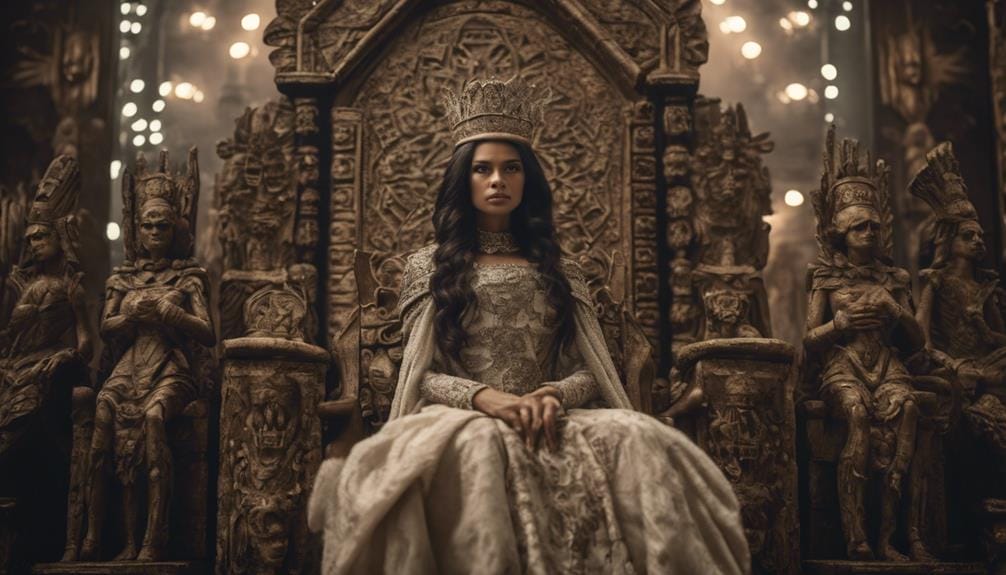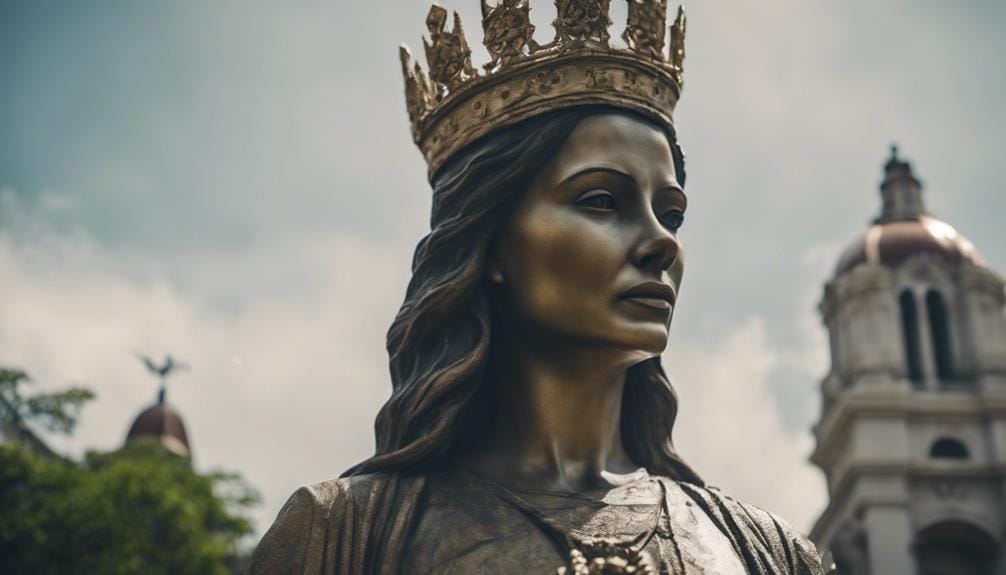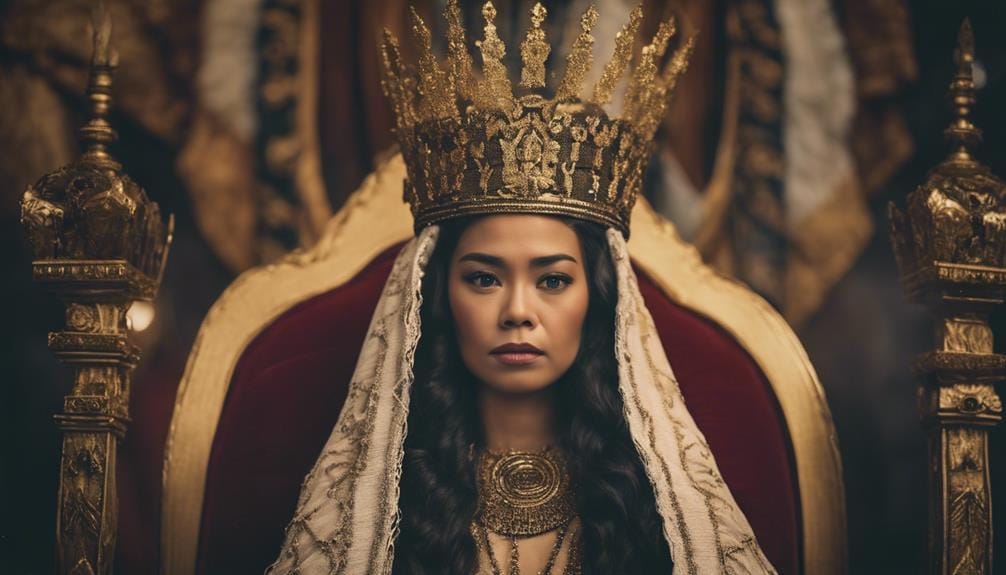Queen Juana of Cebu: Historical Legacy
Queen Juana of Cebu, also known as Hara Humamay, holds a pivotal place in the history of Cebu and the Philippines. Her story is intertwined with significant events during the arrival of Ferdinand Magellan’s expedition, showcasing a blend of cultures and the complexities of colonial interactions.
As you uncover Queen Juana’s journey from embracing Christianity to her reign alongside Rajah Humabon, you’ll find yourself intrigued by the lasting impact she had on Cebu’s cultural landscape and the enduring legacy she left behind.
Key Takeaways
- Queen Juana of Cebu was the first Filipina to embrace Christianity, impacting Cebu’s cultural landscape.
- Her acceptance of Christianity marked a significant cultural blending between indigenous beliefs and colonial influence.
- Queen Juana’s diplomatic strategies and alliances solidified her authority in precolonial Cebu.
- The Sinulog festival celebrates Queen Juana for her conversion and influence on the Philippines’ religious landscape.
Early Life of Queen Juana
Queen Juana of Cebu’s upbringing and formative years provide crucial insights into her pivotal role in the religious transformation of precolonial Cebu. As the primary wife of Rajah Humabon, Juana held a significant position within Cebu’s societal hierarchy. Her baptism by Ferdinand Magellan’s crew in 1521 signified a monumental shift in her life and the history of the Philippines.
Renamed Juana after the baptism administered by Fr. Pedro Valderrama, she also received the revered Image of Santo Niño, a symbol of her Christian conversion. This event marked her as the first Filipina to embrace Christianity, showcasing her influential cultural impact.
Queen Juana’s acceptance of Christianity not only altered her personal beliefs but also played a crucial role in the wider Christianization of Cebu. Despite the limited historical records available, Queen Juana’s legacy echoes through the annual Sinulog festival, celebrating her role in shaping the religious and cultural landscape of Cebu. Her early life choices and adoption of Christianity underpin her enduring cultural influence and the enduring legacy she left on precolonial beliefs and practices in Cebu.
Rise to Power

Ascending to prominence as the primary consort of Rajah Humabon, Queen Juana of Cebu solidified her authority through strategic alliances and diplomatic maneuvers in precolonial Cebu. Her pivotal role in the conversion to Christianity began with her baptism, a significant event that marked her official acceptance of the faith.
Alongside 800 other Cebuanos, Queen Juana embraced Christianity, symbolizing the start of cultural blending between indigenous beliefs and colonial influence. This momentous decision not only altered her personal beliefs but also had a profound impact on the religious landscape of Cebu. Her conversion played a crucial role in the early stages of Christianity’s spread in the Philippines, setting the stage for the region’s future religious trajectory.
Celebrated annually during the Sinulog festival, Queen Juana’s rise to power and her embrace of the child Jesus hold immense historical significance, highlighting her enduring legacy in shaping Cebuano history and the cultural tapestry of the region.
Reign and Achievements

During her reign, Queen Juana of Cebu implemented diplomatic strategies and alliances that bolstered her authority and furthered the influence of Christianity in the region.
Queen Juana embraced Christianity during Ferdinand Magellan’s arrival in 1521, becoming the first Filipina to convert in the Philippine Archipelago. She, initially known as Queen Humamay, was baptized with 800 Cebuanos on April 24, 1521, by Fr. Pedro Valderrama, who gave her the Christian name Juana.
The Image of Santo Niño discovered in Cebu in 1565 is believed to be a gift from Magellan to Queen Juana, symbolizing her pivotal role in the early Christianization of the region. Queen Juana’s baptism marked a significant moment in the history of Cebu, laying the foundation for the spread of Christianity throughout the Philippines.
Cultural Impact

The acceptance of Christianity by Queen Juana of Cebu had a profound cultural impact, symbolizing the enduring influence of faith in shaping the Philippines’ religious landscape. Queen Juana’s reverence for the Santo Nino, the child Jesus, during the Sinulog festival in Cebu, highlights the fusion of indigenous beliefs with Christian practices.
Manuel Panares, a Filipino artist, immortalized Queen Juana’s devotion in his paintings, showcasing her pivotal role in embracing Christianity in Cebu. Her story reflects the intricate cultural interactions that took place during Spanish colonization in the Philippines, where traditions intertwined, giving rise to new expressions of faith and identity.
The Sinulog festival, which commemorates Queen Juana’s spiritual journey, serves as a vibrant testament to the blending of cultures and the resilience of belief systems in the face of change. Queen Juana’s legacy as a key figure in Cebu’s history endures through the continued celebration of festivals and the preservation of cultural traditions that honor her pivotal role in embracing Christianity amidst the challenges of Spanish colonization.
Did Queen Juana of Cebu Have any Connection to the Old House in Cebu?
The old house echoes Cebu from the time of Queen Juana, as it is rumored to have a connection to her. The mysterious history behind the house has attracted many curious visitors and has sparked various legends associated with the queen’s reign in Cebu.
Legacy and Remembered Influence

Queen Juana of Cebu’s lasting legacy and remembered influence resonate through the vibrant celebrations and cultural traditions that honor her pivotal role in the history of Christianity in the Philippines.
- The Sinulog festival in Cebu celebrates Queen Juana for embracing Christianity during Magellan’s expedition.
- Filipino artist Manuel Panares depicted Queen Juana’s conversion to Christianity and her devotion to the Santo Niño.
- Dances at the Sinulog festival symbolize Queen Juana’s acceptance of Christianity and its spread in the Philippines.
- Queen Juana’s story reflects the intricate cultural interactions during Spanish colonization and the fusion of indigenous and colonial beliefs.
- Her legacy as a key figure in Cebu’s history is remembered through festivals and her influence on the religious landscape of the Philippines.
Through these commemorations and artistic representations, Queen Juana’s impact on the religious and cultural fabric of Cebu and the wider Philippines endures, highlighting the complexities of historical narratives and the blending of traditions in shaping societies.
Conclusion
In conclusion, Queen Juana of Cebu played a crucial role in the spread of Christianity in the Philippines and served as a symbol of cultural blending during Spanish colonization. Her acceptance of the new faith and her leadership in embracing change showcased the complexities of cultural interactions during that time.
Queen Juana’s legacy continues to be celebrated and explored, highlighting her significance in Cebu’s history and her lasting influence on the cultural landscape of the region.
And to complete your Cebu experience, Southpole Central Hotel awaits, offering unparalleled comfort, convenience, and personalized service in the heart of the city. Experience the perfect blend of relaxation and exploration during your stay with us.
Frequently Asked Questions
Who Was the Queen of Cebu?
You were curious about the queen of Cebu. She wielded political power, embraced religious conversion, navigated trade relations, and embodied leadership qualities. This blend of Spanish influence and indigenous culture shaped her historical significance.
What Gift Did Magellan Give to Queen Juana?
Magellan presented a significant gift symbolizing cultural exchange and Spanish influence. The act showcased historical diplomacy and cross-cultural communication through traditional customs. The royal reception highlighted diplomatic gestures and potential political alliances.
What Image Was Given to Queen Juana?
When the Image was presented, it signified a pivotal moment in history. Its arrival marked a shift in cultural assimilation, power dynamics, religious conversion, and colonial encounters. Its legacy and influence remain significant to this day.
What Is the Real Name of Reyna Juana?
The real name of Reyna Juana of Cebu, a historical figure in Philippine history during Spanish colonization, reflects the royal lineage and cultural significance of indigenous leaders. She was a powerful ruler among women in leadership, challenging historical misconceptions.







